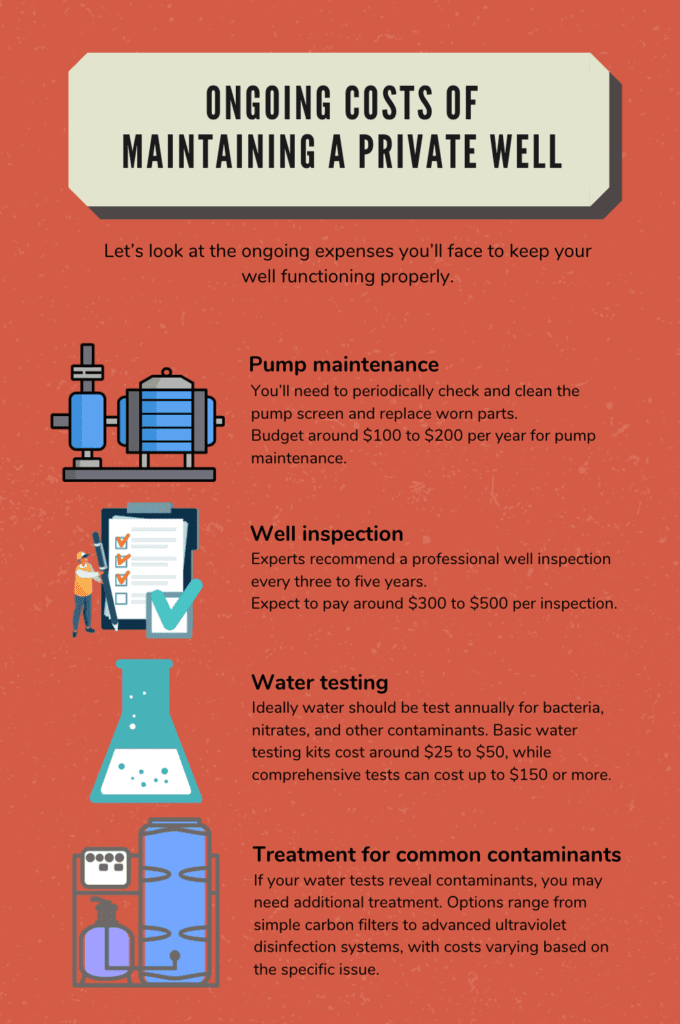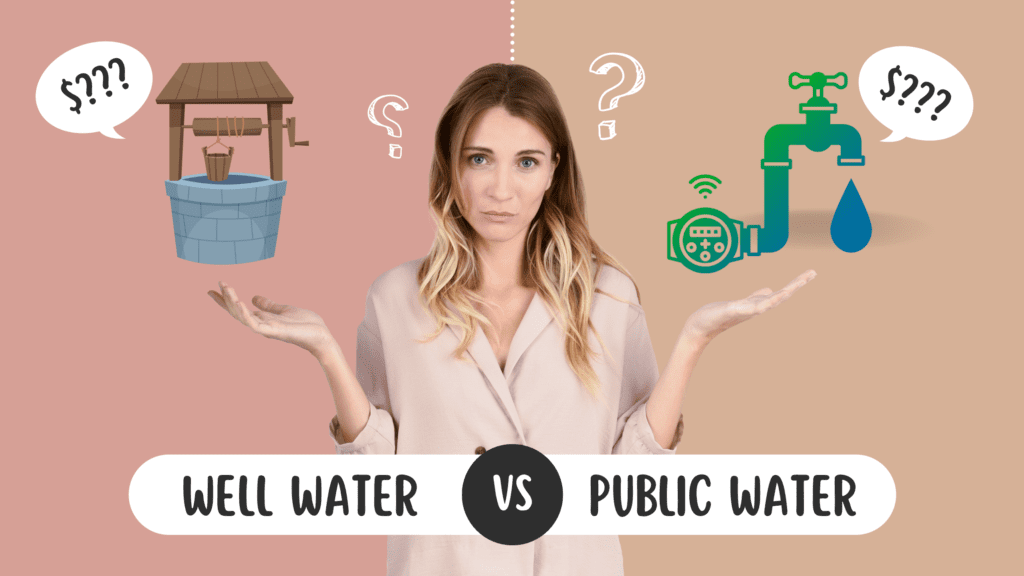So, you live in a rural or suburban area, and you’re thinking about private well water instead of public water. It’s great for controlling water quality, feeling self-sufficient, and maybe even saving some cash.
But here’s the catch – people often think well water is “free” since there’s no monthly bill like with city water. Sure, you don’t pay directly for the water, but owning and maintaining a private well isn’t without its costs.
In this blog post, we’re going to dive deep into the real costs of private well water. We’ll cover everything from installing a well and ongoing maintenance to hidden costs and risks. We’ll also compare well water to public water supply costs.
By the end, you’ll know if a private well is as cost-effective as it seems and if it’s the right fit for your family.
Initial Costs of Installing a Private Well
Before we dive into the ongoing costs, let’s first talk about the expenses you’ll face when installing a private well.
Land survey and permit costs
Before drilling your well, you’ll need a land survey and possibly permits. A land survey helps you determine the best spot for your well, taking into account factors like soil type and proximity to septic systems.
Permit costs vary by location, so check with your local authorities for specific prices.
Drilling and casing costs
Once you’ve secured the necessary permits, it’s time to drill. Drilling and casing costs depend on factors like well depth, location, and soil conditions.
Generally, you can expect to pay between $15 and $30 per foot for drilling, plus additional costs for casing materials.
Pump installation and setup
After drilling, you’ll need to install a pump to bring water to the surface. Pump costs vary based on the type and horsepower needed, but a submersible pump for a typical residential well can cost between $500 and $1,200.
Don’t forget to factor in labor costs for installation.
Water treatment systems
Depending on your water quality, you may need a treatment system to remove contaminants or improve taste. Treatment systems can range from simple sediment filters (around $100) to more sophisticated reverse osmosis systems (upwards of $1,000).
In summary, initial costs for a private well can add up quickly. But once it’s installed, you’ll need to think about the ongoing expenses to keep your well running smoothly.
Ongoing Costs of Maintaining a Private Well

Now that we’ve covered the initial costs, let’s look at the ongoing expenses you’ll face to keep your well functioning properly.
Regular maintenance and servicing
Pump maintenance
To keep your well water flowing, regular pump maintenance is essential. You’ll need to periodically check and clean the pump screen and replace worn parts.
Budget around $100 to $200 per year for pump maintenance.
Well inspection
Experts recommend a professional well inspection every three to five years. This check-up will ensure your well is in good shape and catch potential issues early.
Expect to pay around $300 to $500 per inspection.
Water quality testing and treatment
Annual water testing
It’s a good idea to test your well water annually for bacteria, nitrates, and other contaminants. Basic water testing kits cost around $25 to $50, while comprehensive tests can cost up to $150 or more.
Treatment options for common contaminants
If your water tests reveal contaminants, you may need additional treatment. Options range from simple carbon filters to advanced ultraviolet disinfection systems, with costs varying based on the specific issue.
Repair and replacement expenses
Lifespan of well components
Well components have varying lifespans. Pumps typically last 10 to 15 years, while pressure tanks can last 20 to 25 years. Replacing these components can cost hundreds or even thousands of dollars.
Common repair scenarios
Repairs can crop up unexpectedly. Examples include fixing a malfunctioning pump, replacing a broken pipe, or addressing a contaminated well.
These repairs can range from a few hundred to several thousand dollars.
Electricity costs for pumping water
Don’t forget to factor in electricity costs to power your well pump. These costs will vary based on your local electricity rates and pump usage, but can add up to several hundred dollars per year.
Clearly owning a private well comes with a range of ongoing costs. Staying aware of these expenses will help you budget appropriately and ensure your well remains a cost-effective water source.
Hidden Costs and Risks of Well Ownership
Aside from the initial and ongoing costs, there are hidden costs and risks associated with owning a private well that you should consider.
Diminished property value
In some cases, having a private well can negatively impact your property value, especially if potential buyers prefer the convenience of a public water supply. Be prepared for this possibility when it’s time to sell your home.
Contamination risk and liability
Well water can become contaminated from various sources like septic systems, agricultural runoff, or industrial waste.
If your well becomes contaminated, you may be liable for any resulting health issues or environmental damage, which could lead to costly legal battles.
Drought and water supply issues
During periods of drought or heavy water usage, your well may run dry or produce less water. Drilling a deeper well or implementing water conservation measures can be expensive, and in extreme cases, you may need to find an alternative water source temporarily.
Potential conflicts with neighbors over water rights
In some areas, water rights disputes can arise between neighbors with shared water resources. These disputes can lead to legal battles and strained relationships, both of which can be costly in terms of time, money, and stress.
By considering these hidden costs and risks, you’ll have a more complete understanding of what it means to own a private well and can make an informed decision about whether it’s the right choice for you.
Comparing Costs: Private Well Water vs. Public Water Supply

Now that we’ve explored the various costs and risks associated with private well ownership, let’s compare it to the costs of relying on public water supply.
Average costs of public water supply
The average cost of public water supply varies by location, but as a general rule, you can expect to pay around $40 to $100 per month for a family of four.
Keep in mind that these costs may increase over time due to infrastructure upgrades, inflation, or changes in local water rates.
Factors influencing the cost of well water
As we’ve seen, the cost of well water depends on a variety of factors, such as the initial installation costs, ongoing maintenance, electricity, water treatment, and potential hidden costs.
It’s crucial to consider these factors when estimating the overall cost of well water for your specific situation.
Breakeven analysis: when does well water become more cost-effective?
To determine when well water becomes more cost-effective than public water supply, you’ll need to compare the total costs of each option over time.
Start by calculating the initial and ongoing costs of a private well, and compare that to the cost of public water supply over the same period.
For example, if the total initial cost of installing a well is $10,000, and the ongoing costs are $1,000 per year, the total cost after ten years would be $20,000.
In comparison, if public water costs $70 per month, the total cost after ten years would be $8,400. In this case, well water would not be more cost-effective.
However, each situation is unique, and the breakeven point will depend on your specific costs and water usage patterns.
If your well water costs are significantly lower than the public water supply, or if your water usage is much higher than average, a private well may become more cost-effective sooner.
By carefully analyzing and comparing costs, you can make a more informed decision about whether a private well or public water supply is the best option for your family.
Conclusion
In this blog post, we’ve taken a comprehensive look at the true costs of private well water ownership. We’ve explored the initial costs of installing a well, ongoing maintenance and servicing expenses, hidden costs and risks, and compared these to the costs of public water supply.
While there are benefits to owning a private well, such as increased control over water quality and potential cost savings, it’s important to maintain a balanced perspective.
The expenses and risks associated with well ownership can be substantial, and the decision to switch from public water supply should not be taken lightly.
Ultimately, it’s essential to carefully consider your water supply options, taking into account your specific needs, budget, and long-term plans.
By doing so, you can make an informed decision that will provide your family with a safe, reliable, and cost-effective source of water for years to come.

